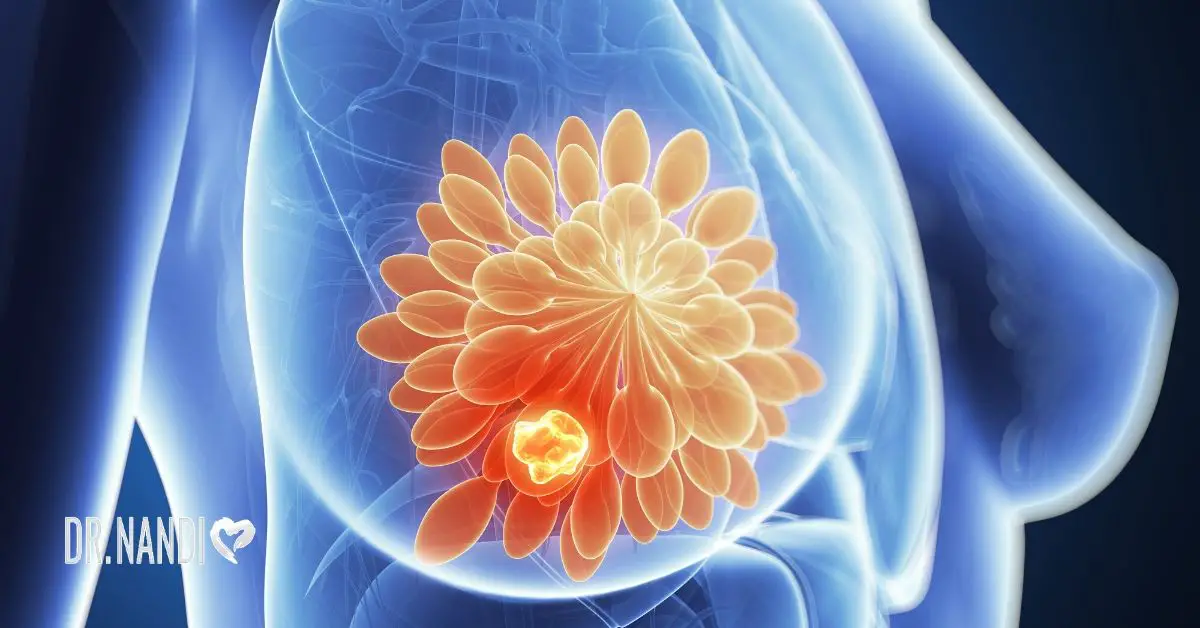What Is Breast Cancer?
Breast cancer is the name given to the type of cancer that originates in breast tissue.
The cells in your body regularly reproduce to replace dying cells. Cancer occurs when those cells keep producing at a rate faster than they’re supposed to, causing tumors. A process called “programmed cell death,” or apoptosis is used by the body to get rid of cells that don’t need to be there. Cancer cells can ignore these signals. If these cells do not die but continue to reproduce, it’s cancer.
Often, cancer cells can break away from the primary cancer site and spread to other parts of the body through blood or other body systems. There, they can start dividing and growing. It is called secondary cancer, and the process is known as metastasis. There are two most common types of breast cancer. The most frequent type of breast cancer is ductal carcinoma, which starts in the lining of the milk ducts. The second most common type of breast cancer is lobular carcinoma, which begins in the breast’s lobules (milk glands).
Symptoms Of Breast Cancer
Symptoms of breast cancer can be easily mistaken for other illnesses. Please visit a doctor if you have any of the below:
- Breast lump
- Breast pain
- Changes in size, feel, or shape of a breast.
- Skin changes
- Change in the position of your nipple
- Fluid leaking from your nipple
Breast Lump
While 8 out of 10 breast lumps are benign, and therefore not cancer, one of the first signs of breast cancer can be a lump in the breast tissue. It’s essential to perform regular checks and make sure that you go to your doctor with any concerns about new lumps in the breast.
Breast Pain
Breast pain is rarely the first sign of breast cancer, as there are many other causes of breast pain. Usually, it’ll go away by itself after some time, and tests can often find no cause. However, please see a doctor if breast pain is combined with any other symptoms or if it doesn’t alleviate with time.
Changes in Size, Feel or Shape of a Breast
You know your breasts (men included) better than anyone else. So you’re in a unique position to identify any changes or unusualness in your breast tissue.
Many healthy women find that their breasts feel lumpy and tender before their period. Therefore, changes in size, shape, or feel of a breast aren’t always indicative of some underlying issue. You know your body and what is normal for you throughout the month. Regular breast checks can help you understand your breasts’ average size, shape, and feel and should be performed often. If you have unusual changes in your breasts, such as them being a different shape or feeling lumpy, please make sure you see a doctor.
Skin Changes
One of the more common changes to the skin, indicating something is wrong, is ‘orange peel skin.’ It is where the skin begins to look a little like orange peel and feel a different texture; dimpled, puckered. Other skin changes include redness or a rash. It’s best to get these changes looked at by a doctor to clarify anything serious.
Nipple Position Changes
Some people naturally have nipples that are inverse rather than pointing outwards. Most people do not. If yours change from one to the other, it could signify that something is wrong. Change in the direction of where the nipple is pointing can also be a concern.
Fluid Leaking From the Nipple
In a pregnant or breastfeeding woman, fluid from the nipple is perfectly normal and nothing to be concerned about. However, suppose this occurs in someone neither pregnant nor breastfeeding. In that case, it can be a symptom of many things, including breast cancer. Always visit a doctor if you have unexplained fluid leaking from the nipple.
Who Can Get Breast Cancer?
It’s a myth that only women can get breast cancer. It is a dangerous misconception. Men who find a lump in their breast tend to delay going to their doctor until much later when there are other more severe symptoms such as bleeding from the nipple. They may ignore these symptoms so that cancer could have spread throughout the body.
Who Is at Risk of Developing Breast Cancer?
The risks of developing breast cancer come in two categories: those that can be mitigated and those that you can’t do anything about. The ones you can’t do anything about include age and genetics, whereas you can alter lifestyle and habits.
Most breast cancers occur in women over 50, and it is rare in women under 40. Most breast cancers happen in men between ages 60 and 70, and it’s rare in men under 35.
Having a mother, sister, or daughter diagnosed with breast cancer approximately doubles the risk of breast cancer. This risk is higher when more close relatives have breast cancer or if a relative develops breast cancer under 50.
The main risk factors for developing breast cancer are:
- Older age
- A personal history of breast cancer or benign (non-cancer) breast disease
- Inherited risk of breast cancer through genetics and family history
- Dense breasts
- Exposure of breast tissue to estrogen made in the body
- Taking hormone therapy for symptoms of menopause
- Radiation therapy to the breast or chest
- Obesity
- Drinking alcohol
- Smoking
As you can see, not all of the above factors are in your control.
How to Decrease Risk of Developing Breast Cancer
Anything that increases the risk of getting a disease is called a risk factor. This section will look at the risk factors that you have control over and which you can change to lower the risk as much as possible. Unfortunately, avoiding risk factors and increasing protective factors does not guarantee you will not get cancer. Still, it does lower the risk of you getting cancer.
There are currently studies looking into the different ways to help prevent cancer, such as:
- Changing lifestyle or eating habits.
- Avoiding things known to cause cancer.
- Risk-reducing surgery.
Changing Lifestyle or Eating Habits
Anything that can lower the risk of developing breast cancer is a protective factor. A person can make many lifestyle choices to minimize developing breast cancer. Lifestyle and habits, on the other hand, can be changed to lessen the risk.
Lose Weight or Maintain a Healthy Weight
Studies have found links between breast cancer and obesity. Therefore, if you are obese, you have more risk of developing breast cancer. Studies have shown that obesity substantially raises the risk of morbidity from many conditions, illnesses, and diseases, including breast cancer. Losing weight and maintaining a healthy weight can help to minimize the risk. Having a healthy diet can also be a protective factor against cancer.
Quit Smoking
Smoking tobacco might increase your risk of getting breast cancer. It increases your risk of getting cancer overall. Still, it’s difficult to say if there is a link between it and breast cancer.
Poisons used in the manufacture of cigarettes are released when smoked. These poisons can make it harder to kill cancer cells, meaning they can keep growing and replicating without being stopped. The toxins can also cause tumors to be created by damaging the parts of the cells’ DNA that regulate growth.
Regardless of whether you smoke, it is never too late to stop smoking, but the sooner you stop, the better the chance your body will have to recover.
Exercise Regularly
Regular exercise can help with weight loss, but it can also be a protective factor. Studies show that those participating in higher physical activity levels have a reduced likelihood of developing various cancers compared to those who engage in lower physical activity levels.
Lower Your Alcohol Consumption
Over 100 studies have demonstrated an increased risk of breast cancer with increasing alcohol consumption. The less alcohol you drink, the lower your risk of cancer, including breast cancer.
Avoiding Carcinogenic Products
Staying away from substances and situations with known cancer risks is a great way to lower the risk of developing breast cancer. The EPA has an extensive list of products that are carcinogenic or capable of causing cancer to humans, and another of those known to be human carcinogens.
Risk-Reducing Surgery
Often, suppose there is a family history of breast cancer. In that case, women can elect to have surgery to remove their breasts, a mastectomy. Even if the woman displays no signs of having breast cancer herself, it can happen as a preventative measure if the risk is high.
Stages of Breast Cancer
Breast cancer, like all cancers, can come in different stages, types, and grades. In Stage 1, there are often precancerous cells. In Stage 4, breast cancer has spread to completely other parts of the body.
Methods for Treating Breast Cancer
Depending on what stage the breast cancer is, the treatment will vary.
- As well as being a preventative measure to avoid breast cancer in the first place, mastectomies can also be used to treat cancer.
- For example, doctors can utilize a lumpectomy if the cancer is contained in one tumor. It is where they remove cancer itself and leave the other breast tissue in place.
- Chemotherapy is the most commonly used treatment for all types of cancer. It utilizes drugs that interfere with a cell’s ability to reproduce. It comes with many side effects and can often make the patient feel ill while treating cancer.
- Radiation is also used to treat certain cancers, such as breast cancer.
Frequently Asked Questions
Can only women get breast cancer?
No. Men are also at risk of developing breast cancer; it’s just that the stakes aren’t as high as for women.
How often should I do a breast exam?
As often as possible. There is no such thing as too many at-home self-exams. It will alert you to any unusual changes in your breasts, but it’s also a great way to know your own body better. The recommended minimum is once per month.



















